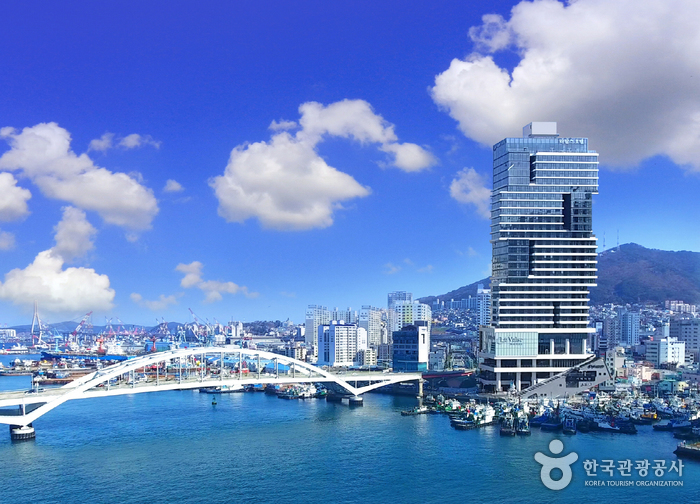Busandaegyo Bridge (부산대교)
560.2M 2025-10-23
41 Namhang-ro 9beon-gil, Yeongdo-gu, Busan
+82-51-600-4000
Built in 1980, Busandaegyo Bridge connects Yeongdo Island to the mainland. It serves as an industrial road that facilitates the transport of freight and cargo from Yeondong-gu District, the center of the shipbuilding industry and an emerging port.
Busandaegyo Bridge is 694 meters long and 20 meters wide, with 16 meters for cars and 2 meters of sidewalk on each side. Compared to other bridges built around the same time, Busandaegyo Bridge has a greater significance in the hearts of the citizens as it was built to commemorate the 100th anniversary of Busan Port and symbolizes the development of the city.
Olive Young - Gwangbok Main Branch [Tax Refund Shop] (올리브영 광복본점)
568.9M 2024-04-22
1F, 36, BIFF gwangjang-ro, Jung-gu, Busan
-
Gukje Market (국제시장)
586.5M 2025-10-23
Area of Sinchang-ro 4-ga, Jung-gu, Busan
+82-51-245-7389
The current marketplace of Gukje Market first formed after the liberation of Korea from the Japanese administration when people gathered to trade overseas products left by the Japanese and brought in by Koreans who came back from abroad. Following the Korean War, refugees who fled to Busan set up stalls in order to make a living by selling smuggled or imported products, which developed into Gukje Market (gukje meaning "international" in Korean) of today. Gukje Market is one of Korea’s largest markets and a testament to Korea's modern history. The market is divided into two wings, and first-timers to the market are advised to be careful not to get lost in the maze-like alleys and halls.
Gukje Market Food Street (국제시장 먹자골목)
616.9M 2024-03-06
36, Junggu-ro, Jung-gu, Busan
+82-51-245-7389
Gukje Market Food Street has more than 60 years of history as one of Busan's traditional markets' most famous food streets. It is known for a number of dishes, such as Chungmu gimbap served with sweet and sour squid salad, sweet-and-spicy tteokbokki, milmyeon (wheat noodles), dwaeji gukbap (pork and rice soup), sundae, patbingsu (shaved ice with red beans), and Busan’s iconic bibim dangmyeon (spicy glass noodles). These dishes are enjoyed on small stools next to the street stalls. The sight of the diners lining the stall is one of the defining views of traditional markets in Korea. Visitors can also find suitable clothing, shoes, and accessories here.
Artbox - Busan Gwangbok Branch [Tax Refund Shop] (아트박스 부산광복)
618.5M 2024-04-23
28, BIFF gwangjang-ro, Jung-gu, Busan
-
Ai Hasi - Busan Gukje Market Branch [Tax Refund Shop] (아이하시 부산국제시장)
636.5M 2024-04-18
1F, Bldg. A of Ihasi, 33, Gukjesijang 2-gil, Jung-gu, Busan
-
Daiso - Busan Gukje Market Branch [Tax Refund Shop] (다이소 부산국제시장)
673.1M 2024-04-18
1F, 13, Junggu-ro, Jung-gu, Busan
-
Yeongdodaegyo Bridge (영도대교)
695.2M 2023-04-22
46, Taejong-ro, Yeongdo-gu, Busan
+82-1670-8114
Yeongdodaegyo Bridge, connecting Nampo-dong and Yeongdo Island, was the first bridge to connect the mainland to one of the nearby islands in Busan. The bridge lifted to allow ships to pass between the south and north ports, and made a passage for ships anywhere from two to seven times in one day. When the bridge was first constructed, many people would gather to watch the strange spectacle of a bridge rising up to point to the sky. The bridge remains a famous landmark of Busan even to this day.
Nonghyup Hanaro Mart - Jagalchi Branch [Tax Refund Shop] (농협하나로마트 자갈치)
700.2M 2024-04-22
73, Gudeok-ro, Jung-gu, Busan
-
La Valse Hotel Busan (라발스호텔)
729.5M 2024-12-22
82 , Bongnaenaru-ro, Yeongdo-gu, Busan
+82-51-790-1500
The 29 storey La Valse Hotel in Yeongdo-gu, Busan, offers a variety of rooms, most of which have a fine view of the Sea. The Standard Terrace Ocean Rooms have a terrace as well as a bathtub, and the Corner Double City and Double Ocean Rooms have a window glass wall and an ocean vista. At the 28th floor Sky Cafe and Pub guests can even enjoy their breakfast with a sea view. Nampo Subway Station and Kkanggangi Art Village are 10 minutes away on foot, and Jagalchi Market and the Songdo Marine Cable Car are 10 minutes away by car.
![Olive Young - Gwangbok Main Branch [Tax Refund Shop] (올리브영 광복본점)](http://tong.visitkorea.or.kr/cms/resource/45/2885845_image2_1.jpg)


![Artbox - Busan Gwangbok Branch [Tax Refund Shop] (아트박스 부산광복)](http://tong.visitkorea.or.kr/cms/resource/70/2885870_image2_1.jpg)
![Ai Hasi - Busan Gukje Market Branch [Tax Refund Shop] (아이하시 부산국제시장)](http://tong.visitkorea.or.kr/cms/resource/11/2889711_image2_1.jpg)
![Daiso - Busan Gukje Market Branch [Tax Refund Shop] (다이소 부산국제시장)](http://tong.visitkorea.or.kr/cms/resource/15/2889115_image2_1.jpg)
![Nonghyup Hanaro Mart - Jagalchi Branch [Tax Refund Shop] (농협하나로마트 자갈치)](http://tong.visitkorea.or.kr/cms/resource/90/2888190_image2_1.jpg)

 English
English
 한국어
한국어 日本語
日本語 中文(简体)
中文(简体) Deutsch
Deutsch Français
Français Español
Español Русский
Русский